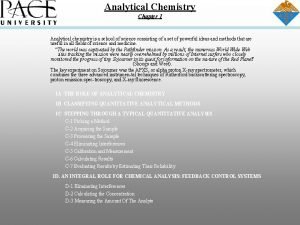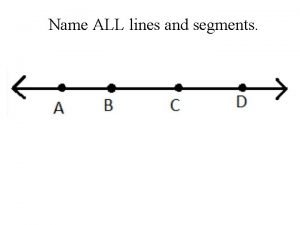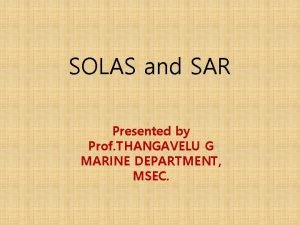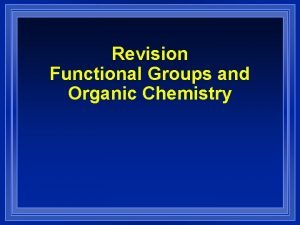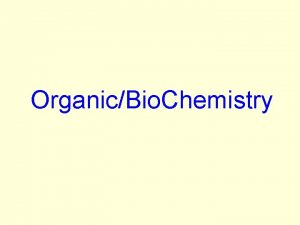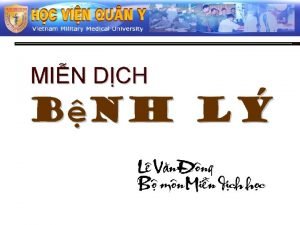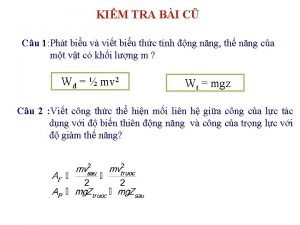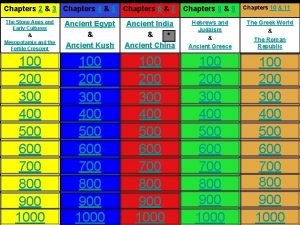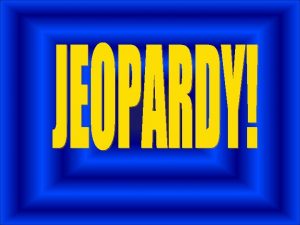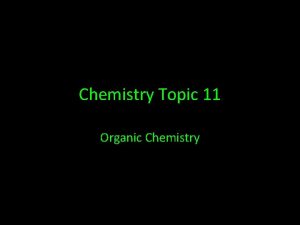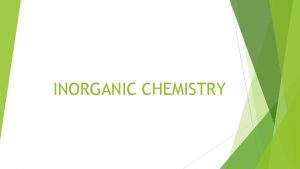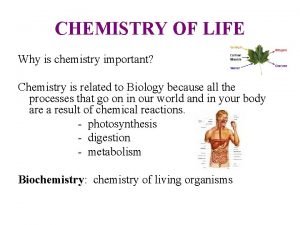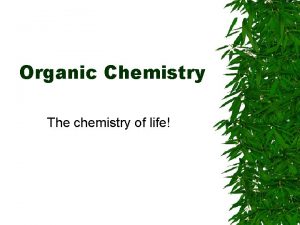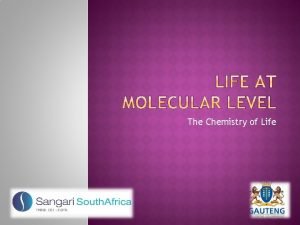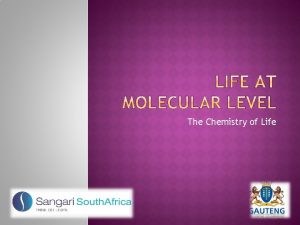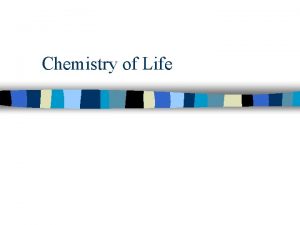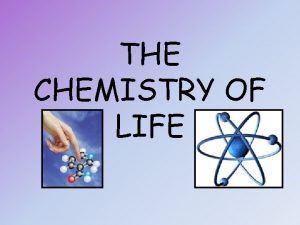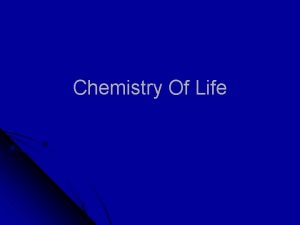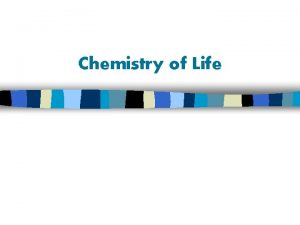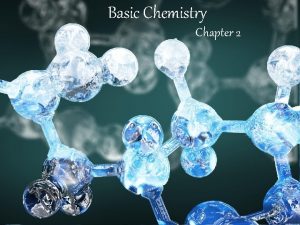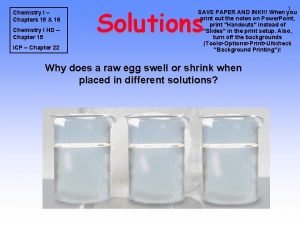CHAPTERS 4 5 The Chemistry of Life All





















- Slides: 21

CHAPTERS 4 & 5 The Chemistry of Life

All Matter Consists of Elements Made of Atoms, the smallest functional unit, consist of: • Protons: positive charge, have mass • Neutrons: no charge, have mass • Electrons: negative charge, have no discernable mass Slide 2. 1


Major Elements of the Human Body • Oxygen (O) • Carbon (C) • Hydrogen (H) • Nitrogen (N)

Isotopes • Same element, same atomic # = same # of protons and electrons • Different number of neutrons = different weight Radioisotopes • Are unstable (varies with isotope) ex. : I 131 used in the treatment of Grave’s Disease • Emit energy (radiation) • Emit particles

Atoms Combine to Form Molecules • Joining atoms requires energy • Energy is the capacity to do work • Stored energy = potential energy • Energy in motion, doing work = kinetic energy • Electrons have potential energy • Shells = the energy levels of electrons • Orbitals describe the probable location of an electron .

Factors Influencing Rate of Chemical Reactions • Temperature – chemical reactions proceed quicker at higher temperatures • Particle size – the smaller the particle the faster the chemical reaction • Concentration – higher reacting particle concentrations produce faster reactions • Catalysts – increase the rate of reaction without being chemically changed • Enzymes – biological catalysts

Three Types of Chemical Bonds

Life Depends on Water • Water molecules are polar (they have slight electrical charges) • Water is liquid at body temperature • Water can absorb and hold heat energy Slide 2. 6

Two Important Biological Functions of Water • Water is the biological solvent • Water helps regulate body temperature • Has high heat of evaporation

The Importance of Hydrogen Ions • Acids are proton (H+) donors, bases accept hydroxide (OH-) ions • p. H Scale = a log scale of the H+ concentration (going from a p. H of 2 to 4 is a change of 2 numbers= 102, so p. H 4 is 100 times less acidic than p. H 2) • Buffers: minimize p. H change (Carbonic acid and bicarbonate act as one of body’s most important buffer pairs)

The Organic Molecules of Living Organisms Carbon, the building block of living things: • Comprises 18% of body by weight • Forms four covalent bonds • Can form single or double bonds • Can build micro- or macromolecules Carbohydrates Lipids Proteins Nucleic Acids Slide 2. 11

Carbohydrates - Energy and Structural Support • Oligosaccharides: short chains of monosaccharides • Disaccharides: sucrose, fructose, lactose • Polysaccharides: thousands of monosaccharides joined in chains and branches • Starch: made in plants; stores energy • Glycogen: made in animals; stores energy • Cellulose: undigestible polysaccharide in plants for structural support

Dehydration synthesis: Links molecules together, byproduct = water

Lipids: Insoluble in Water • Triglycerides: energy storage molecules • Fatty acids: saturated and unsaturated • Phospholipids: cell membranes • Steroids: carbon-based ring structures • Cholesterol: steroid used in making estrogen and testosterone

Proteins: Complex Structures Constructed of Amino Acids • Primary: amino acid sequence • Secondary: describes chain’s orientation in space; e. g. , alpha helix, beta sheet • Tertiary: describes three-dimensional shape created by disulfide and hydrogen bonds • Quarternary: two or more protein chains are associated

Hemoglobin = 4 proteins

Enzyme Function Enzymes: • Vital proteins • function as catalysts • facilitate chemical reactions The functional shape of an enzyme is dependent on: • temperature of reaction medium • p. H • ion concentration • presence of inhibitors

Structure and Function of Nucleic Acids • Functions • Store genetic information • Provide information used in making proteins • Structure • Nucleotides: a phosphate group, a sugar, and a nitrogenous base • DNA -a double helix: two associated strands of nucleic acids • RNA - a single-stranded molecule

Structure of DNA and RNA • DNA: double-stranded • Sugar: deoxyribose • Nitrogenous bases: adenine, thymine, cytosine, guanine • Pairing: adenine-thymine and cytosine-guanine • RNA: single-stranded • Sugar: ribose • Nitrogenous bases: adenine, uracil, cytosine, guanine • Pairing: adenine-uracil, cytosine-guanine.

Structure and Function of Adenosine Triphosphate (ATP) ATP = Source of immediately usable energy for the cell
 Analytical chemistry chapter 1
Analytical chemistry chapter 1 Name
Name The village by the sea summary chapter 1
The village by the sea summary chapter 1 Solas all chapters
Solas all chapters Life of pi chapters 15-28 summary
Life of pi chapters 15-28 summary Ib organic chemistry
Ib organic chemistry Inorganic vs organic chemistry
Inorganic vs organic chemistry Hình ảnh bộ gõ cơ thể búng tay
Hình ảnh bộ gõ cơ thể búng tay Bổ thể
Bổ thể Tỉ lệ cơ thể trẻ em
Tỉ lệ cơ thể trẻ em Voi kéo gỗ như thế nào
Voi kéo gỗ như thế nào Tư thế worms-breton
Tư thế worms-breton Chúa yêu trần thế
Chúa yêu trần thế Kể tên các môn thể thao
Kể tên các môn thể thao Thế nào là hệ số cao nhất
Thế nào là hệ số cao nhất Các châu lục và đại dương trên thế giới
Các châu lục và đại dương trên thế giới Công thức tính độ biến thiên đông lượng
Công thức tính độ biến thiên đông lượng Trời xanh đây là của chúng ta thể thơ
Trời xanh đây là của chúng ta thể thơ Mật thư anh em như thể tay chân
Mật thư anh em như thể tay chân Phép trừ bù
Phép trừ bù Phản ứng thế ankan
Phản ứng thế ankan
